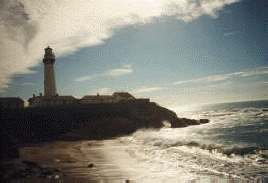Article in Half Moon Bay Review Jan 31,
2007 (reproduced by permission)
Glassy-eyed artist shines
By Stacy Trevenon--[
stacy@hmbreview.com]
At first it was just a little table. Fused-glass artist
Melissa Melissakis set it up in a corner of the two-car garage she shares with
husband Stephen in their home on a quiet Half Moon Bay street. Then, more work
space was needed. Storage space, for cans of "frits" and "confetti" - tiny
pieces of cut glass - or bags of powdered glass like coarse salt in jewel tones.
A kiln.
It all swelled to fill a quarter of that garage. Then it took over half the
garage. Stephen's power saw and tools retreated to the other side.
He came home one day, opened the garage door, and there stood Melissa, holding a
tape measure, looking over what was left.
"The look on his face was, 'Oh, I've lost my garage,'" she said. "But he's got
quite a sense of humor. He thinks it's funny now."
And he probably appreciates what comes out of that pilfered space.
Melissa Melissakis creates decorative pieces or platters of fused glass. They
are either smooth and shining or textured with rippling patterns. They can look
three-dimensional because of air bubbles, or glow with an ethereal sheen through
her use of metal oxides or shimmering "dichroic" glass.
Some are abstract patterns, pleasing cacophonies of bits of opaque or dichroic
glass, sparkles of confetti like jeweled snow flurries and strips of glass with
a metallic cast. Others are like pictures, especially seascapes with Melissakis'
favorite sea horses or sea urchins, plant life, shells and ocean currents in
textures of glass.
"It's sort of like painting in glass," she said.
That's a glib phrase for a multi-step process that can take days for a single
piece, and traces its origins back 4,000 years to the Egyptians.
Melissakis starts by fusing together sheets of glass (she uses lead-free glass).
They may be opaque or translucent, and fusing them yields a distinctive
background. On that she places pieces that make up the design - frits, "stix" of
metallic glass in neon colors, pinches of powdered glass "to add more interest,"
or cut shapes like sea horses.
Into the kiln it goes, where it roasts for 14 hours at temperatures around 1,500
degrees. When it's hot, Melissakis can't give in to the temptation to peek -
expose the piece, even briefly, to the Coastside's moist and cool air, and it
can shatter.
Then comes the 12- to 14-hour cooling period, and finally, Melissakis can open
the kiln door. The finished piece may not be what she envisioned - glass tends
to move when heated "like when you cook an egg," and a precise design might have
shifted.
"When I open that kiln, it's like Christmas every day," she said. "I never know
what I'm going to get because you never know how the heat is going to work on
it. I never know how it will come out."
She admits she's "pretty fast at abstracts" and enjoys them, but a big part of
her creative heart is in her shimmering glass pictures, particularly underwater
scenes.
Those take a lot longer, especially shaping each element. She might cut sea
horses of copper or other metals. She makes feathery sea plants with "stringers"
or ultra-thin sticks of glass that she heats with candles and shapes. Bits of
opaque glass become rocks. Bits of dichroic glass become jellyfish. Several
hours go into the minutiae before it hits the kiln.
The result is a piece like the upright, roughly 16-by-13-inch seascape she
"slumped," or gave a graceful S-shaped curve. It brought her a third-place
ribbon at the 2006 San Mateo County Fair.
Melissakis creates mirrors and designs in clear glass too, using stencils and
carving or etching the design. That process also involves laying sheets of
rubber or vinyl "resist" over the sheet of glass. On a light stand, they come to
three-dimensional life.
Melissakis describes herself as an artist in fused, not blown, glass. A big
difference, she said, is that blowing glass requires temperatures topping 2,000
degrees in a crucible, not a kiln.
She comes by it naturally. A Connecticut native, she was a sculptor in clay
until she reached a point where she "needed to refresh myself."
She took a College of San Mateo glass-fusing class and fell in love with it. It
was a next step for her.
"I wanted to do carving in glass," she said. "And I love colors. I love
vibrancy. I love shine."
She does pay an obvious price for her work with glass: "A lot of owies," she
said. But that won't stop her.
She shows and sells her work at Vibrantz gallery on Main Street in Half Moon
Bay, and she is also a featured artist at Artists Alley at 345 Gough St. in San
Francisco. She, along with a plein air painter, will show their work in a
special show from 6 to 9 p.m. on March 31 at Artists Alley. She also does custom
work.
Melissakis can be reached at
ArtbyMelissa@Melissakis.com.
Glass artist Melissa Melissakis
peers through one of her creations that sits on a light stand to illuminate
her work.

